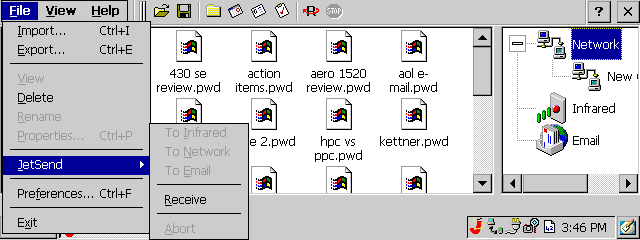|
|
Chris De Herrera's Windows CE Website |
|---|---|
About |
|
| By Chris De Herrera Copyright 1998-2007 All Rights Reserved A member of the Talksites Family of Websites Windows and
Windows CE are trademarks of
Microsoft All Trademarks are owned |
Hewlett Packard Jetsend Review
By Chris De Herrera, Copyright
1999
Version 1.01 Revised 11/29/99
[an error occurred while processing this directive]
Introduction
Hewlett Packard now offers a new utility called Jetsend for Windows CE users to send and receive data from their H/PC, H/PC Pro or P/PC. You can print to Jetsend enabled printers and send/receive files between Windows CE devices as well as the Hewlett Packard Capshare 910.
Concept
Jetsend is designed to allow mobile users to communicate between different devices without using a server or other host. This allows users the flexibility to use devices without installing drivers or worrying about what format the information is in before sending or receiving it. This flexibility is unique since other solutions require users to consider the file type and capabilities of the devices that they are sending information to.
4b>Windows CE Version
In the Windows CE implementation there are 3 components:
1. Jetsend Exchanger – the main application for sending and receiving documents via tcp/ip, e-mail or infrared.
2. Jetsend Viewer – a file viewer for documents and images.
3. Jetsend’s printer driver – an H/PC or H/PC Pro driver that allows users to print directly from applications to Jetsend enabled printers.
These applications allow you to use Jetsend in different ways based on what you want to do.
Jetsend Exchanger

Jetsend Viewer

Printing
Jetsend allows users to print to Jetsend enabled
printers. Pictures are printed in true grayscale. This is substantially
better than the dithering that the included Windows CE driver does for the
H/PC Pro. It also adds the ability to print in color as well. Further,
Jetsend preserves the highest quality that the information contains so if
you send information in color to a grayscale device and then print to a
color printer, it will print in color.
You can print via infrared (IrDA) directly to an HP LaserJet with an
infrared port. Jetsend also supports printing via a TCP/IP network to a
Jetsend enabled printer without using a server. Jetsend includes a printer
driver for the H/PC or H/PC Pro Pros which allow users to select File –
Print and send their document to a Jetsend enabled printer without using
Jetsend Exchanger.
Other Features
You can also use e-mail to send and receive documents for Jetsend. Jetsend includes a viewer for viewing documents sent and received. An example of the interoperability of Jetsend is the ability for users to use the HP Capshare 910 to scan documents and beam them to their Windows CE device.
Current State of the Product
Users will notice that the user interface is designed as if all items to be sent and received from Jetsend is in a special directory. Further, users are required to import and export data to this directory. I recommend that users change their default director from \My Documents\Jetsend to \My Documents so all the documents they have created are available to be used with Jetsend without any additional effort. I’m sure Hewlett Packard will work to improve the way the product works in this regard.
Conclusion
Jetsend is available for free until 2/28/2000 from Hewlett Packard's website. It adds printing to the P/PC and improve the quality of printing for the H/PC and H/PC Pro. Overall, Jetsend is a great addition to any H/PC or P/PC.
[an error occurred while processing this directive]


